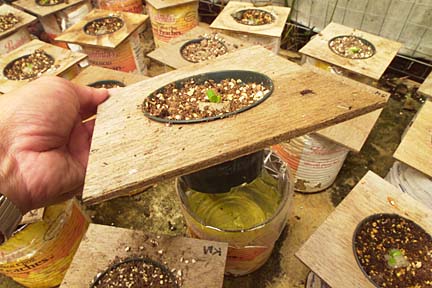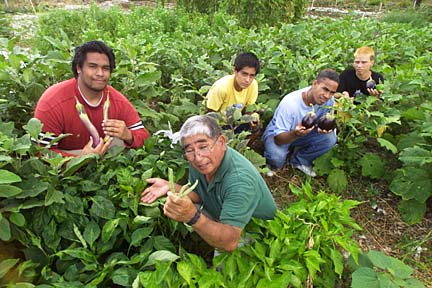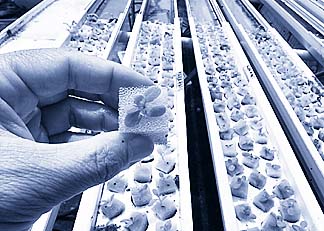


In The Garden![]()
Friday, September 28, 2001

Seeds of knowledge Food was so scarce during World War II that Matsuo Okamoto's family didn't dare throw away the water after they'd boiled potatoes for dinner. The starchy hot water was served with steamed rice to help sustain the family of 19 children.
A retired teacher says growing
vegetables -- one of life's simplest
achievements -- breeds confidenceStarting a hydroponic garden is easy
"We were so poor that sometimes that's all we had to eat, rice and that soup with nothing in it. Still we were better off than some because we grew our own vegetables. If it weren't for the vegetables we grew, we'd starve," recalled Okamoto, who was in second grade when the Japanese attacked Pearl Harbor in 1942.

Okamoto's father, Kanematsu, was known as "the cabbage king of Hawaii," operating a 100-acre farm in Ulupalakua, Maui. The farm produced 15,000 heads of cabbage a day as well as other vegetables. The Okamotos, whose original farm was in Kula, also raised chickens, hogs and cattle.Even though vegetables and animals were plentiful on the farm, they were meant for market and not for the family dinner table. The Okamotos made do with leftovers, and at times that meant having only potatoes or the broth with rice.
"We always had potatoes. The vegetables -- more nutritious -- were more in demand, so they were taken to market. If they sold all the vegetables, that meant we couldn't have any for dinner. But we always had food," he said.

The family ate a lot of vegetables -- mostly cabbage dressed up in catsup and various sauces."When we had meat, it was for Daddy and the older ones. We ate in two shifts. I was the second youngest, so I got to eat in the second shift. The younger ones never saw the meat," Okamoto said.
To make up for what he missed out, Okamoto now favors meat over vegetables. But he can't outgrow his childhood favorite, vine-ripened tomatoes.
"There's nothing like a freshly picked tomato. I eat it just like an apple, just bite into it. It tastes like a real tomato, not like the ones you buy off the shelves," Okamoto said.
Although he's in an extended rebellion against too many veggies in his youth, Okamoto is an advocate for homegrown vegetables of all sorts. They simply taste better when they are fresh, he said, and the home gardener can choose not to use pesticides.

Okamoto shares his gardening know-how in "Backyard Gardening for Beginners," an eight-week course offered through Windward School for Adults. The course covers 16 gardening topics, including hydroponic vegetable gardening. Classes are held at Olomana School and begin tomorrow. Registration is required before the class, but Okamoto will accept walk-ins tomorrow if space is available. Call the adult school, 254-7955, for more information.Okamoto decided against continuing the family farm, due to the long hours of labor required, choosing instead to become an agriculture teacher. He served in the U.S. Army after graduating from high school, then attended Colorado State University for a degree in agriculture education.
He returned to Hawaii and taught at Kapaa High School for one year. When Kailua High School was opened in 1960, he moved to Oahu to begin Kailua's horticulture program.
He retired in 1990, but returned to teaching part time at Olomana School where he maintains an outdoor vegetable garden and an enclosed hydroponic vegetable garden to teach at-risk students the value of growing one's food.

Growing vegetables is one of the easiest tasks to accomplish in life, he said, and success gives students more confidence."I believe that through teaching how to grow vegetables, you can teach about life. You can build confidence and encourage the students gradually. I always say, success breeds success, failure breeds problems," Okamoto said.
In terms of tangible rewards, a vegetable garden is a constant source of healthy, nutritious foods. It is fun to do and may even become a necessity if outside food sources are cut off from the islands.
As long as one follows some general directions, growing vegetables is a fail-safe project, he said. He recommends a non-circulating hydroponic garden as the easiest method. See accompanying story for directions.

Okamoto has 12 students this semester, 11 boys and one girl, who tend the gardens at Olomana School. Lettuce, beans, tomatoes, eggplants, bell peppers and herbs are among the crops cultivated. The students share in the harvest, and the extras are sold to the school staff and others."The students like the harvest, of course. But they really like the hands-on experience. Most of them have never grown anything before, and watching the vegetables grow is an amazing experience for them," Okamoto said.
If the students do not misbehave for the week, Okamoto cooks up the vegetables on Friday as a treat. Having eaten cabbage cooked "a million ways," Okamoto is never short of recipes. His pan-fried green tomatoes and eggplants served with shoyu as a dipping sauce are the favorites with students.
Place: Olomana School, 42-471 Kalanianaole Highway Back yard gardening for beginners
Time: From 1 to 3 p.m. Saturdays for eight weeks beginning tomorrow. Registration required before the class, but walk-ins on Saturday are welcome on a space-available basis
Cost: $32, plus $20 for gardening supplies
Registration: Windward School for Adults, 254-7955, 730 Iliaina St., Kailua
Growing vegetables the old-fashioned way in dirt is easy enough, but growing them in water is even easier. The veggies taste just as good, and nothing gets dirty. Starting a hydroponic
garden is easyMatsuo Okamoto, who has been teaching Hawaii's students how to grow vegetables for 45 years, has modified hydroponic methods for home gardeners. His procedures do not require expensive equipment, and are simple to follow.
"Just use recycled metal cans. You can grow a lot of lettuce -- and everybody eats lettuce -- in those cans," Okamoto said.
Okamoto recommends starting the garden with herbs and leafy greens, such as lettuce and Asian vegetables. They grow fast and have fewer problems with pests. If you want to grow tomatoes, green beans, bell peppers and other larger plants, you'll need bigger containers and more room. They require a trellis, attract more pests and take longer to mature.
The directions here are for growing leafy greens and herbs. Here are the materials you'll need:
1) 3-inch or 4-inch plastic pots for the plants. Drill a small hole in the side of each pot, about an inch below the top rim. Use a leather hole punch or pound a nail through the pot to make the hole.
2) Potting soil. The growing medium must be sterile, but the quality of the soil does not matter. The cheapest soil will do since nutrients for the plants are fed through the water.
3) Vegetable seeds or seedlings. It's best to purchase local seeds, such those produced by the University of Hawaii or Honolulu Seed Company.
4) Recycled cans or plastic containers. Okamoto recommends one-gallon metal coffee or food cans, which are free from school cafeterias and restaurants.
5) Thin plywood or other rigid material to use as covers to keep mosquitoes out. Cut the plywood to fit over the cans, drill a center hole to hold the pot. The hole should be 1/4" smaller than the pot. For example, for a 3-inch pot, the hole should be 2 3/4 inch.
6) Tap water
7) Miracle-Gro
Choose a location with lots of sun light. Place the cans on a flat surface on the ground or table tops so you won't have to bend over to work.
Follow directions on the seed package for planting each vegetable, otherwise here are the general directions to maintain your hydroponics garden:
1) Plant one or two seeds or seedlings in each pot. Make sure there's a small hole in each pot to allow the plant to breathe.
2) Fill the can with water, not to the rim but up to the top ridge. Mix in one teaspoonful of Miracle-Gro, stir well.
3) Fit the pot into the can cover, and place the cover and pot over the can filled with water. The bottom of the pot should be covered by 1/4-inch of water.
4) Leave the new plant undisturbed for one-and-half to two weeks. Afterward, check the water level every few days, making sure that the bottom 1/4 inch of the pot is still soaked in water.
5) After two weeks, the plant will start to use more water. Okamoto recommends changing the water once a week. Throw out the remaining water each week, using it to water plants in the ground. Fill the container with water and fertilizer, following previous directions.
6) Harvest when the vegetables are mature.
Gardening Calendar
Suzanne Tswei's gardening column runs Saturdays in Today.
You can write her at the Star-Bulletin,
500 Ala Moana, Suite 7-210, Honolulu, HI, 96813
or email stswei@starbulletin.com